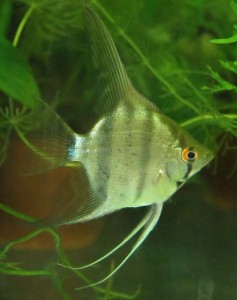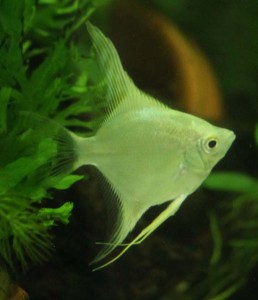Scientific Name Pterophyllum Scalare
Family Cichlidae
pH 6.0 – 7.0
dH 4 – 12
Temp 22 – 28 degrees
Life Span 8+ years
Origin
Angel fish are found in the Amazon Basin, Orinoco Basin & Tributaries in South America.
Description

Angelfish have a distinctive triangular shape. Their body is round with large long dorsal and anal fins. The ventral fins are extremely elongated and the caudal fin is quite wide. Their bodies can be plain, marked or striped with colours varying from white, silver, yellow, blue and black. They can grow up to 6 inches. There are 3 different types of Angelfish. Pterophyllum Scalare, Pterophyllum Leopoldi & Pterophyllum Altum. Pterphyllum Scalare are bred in captivity and are the most common of the three. The other two are obtainable but harder to find. Some varieties of Angelfish you maybe familiar with are Silver, Golden, Koi, Black Lace, Marble, Zebra, Blue Blushing and Albino.
Environment
The ideal temperature for Angelfish is between 22 & 28 degrees. They enjoy a well planted tank where they can hide amongst the vegetation. They are vertical swimmers so tall plants, driftwood, or anything that uses the entire height of the aquarium to hide will make them feel safe and secure. They prefer soft slightly acidic conditions. Water with a pH between of 6.0 – 7.0 and a dH of 4 – 12 is recommended. Make sure to give them good filtration with a gentle flow. To much current will tire them out. Keep them in a tank with a minimum of 40 litres per Angelfish, leaving large areas for them to swim around in. If tank area is too small it can stunt there grow, causing them additional stress that can easily be avoided.
Behaviour

Angelfish are semi-aggressive. They can be placed with other tropical fish. Some compatible fish are Gouramis, Platies, Mollies, Swordtails, Clown Loaches, Corydoras, Plecostomus, Silver Dollars & Tetras. Do not keep them with aggressive fish as they can nip at their fins. This is very stressful for them. Angelfish love to lie in wait and ambush any fish small enough for them to eat. Angelfish are cichlids and it is better to keep a larger group of them in a tank than just 2 or 3. This will help them be more relaxed with each other as they won’t be fighting for supremacy. Males can become very territorial when there are females present, especially in the breeding phase.
Food
Angelfish are omnivores and will eat a wide variety of foods. Flake foods, dried and frozen foods like Brine shrimp & Blood worms. Live foods like mosquito larvae and vegetables. Angelfish will also eat any small sized fish that will fit in their mouths. Like most fish it is always best to give them a mix of foods. High protein for newly hatched fry and during breeding.
Disease
Angelfish like other fish are prone to certain diseases. Ich is one of the most common Angelfish diseases. Also Hole in the head disease, Exophthalmia (Pop eye) and Bacterial & Fungal infections.
Breeding
Sexing Angelfish is extremely difficult and it is best to place a group of Angelfish in a tank and wait for them to pair off naturally. Separate the pair when ready for breeding. Angelfish are egg layers. Only once they are ready to breed will you notice the subtle differences between the male and female. The Papilla will be visible on both the male and female. The female having a thicker tube while the male has a thinner tube. The female Angelfish will neatly lay her eggs in rows having the male follow behind her, fertilizing them. Place a piece of slate, driftwood, large leafed plant, terracotta pot or pipe at an angle of about 30 degrees for them to do this. It will take about 2 days for them to produce tails. At this stage they will be feeding on their yolk sacs. After about 7 days they will become free swimming and feed themselves. A high protein diet will encourage breeding and new fry will benefit from this when in the early growth stage. Separate the fry from their parents as they have a tendency to eat their young.

